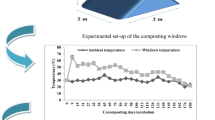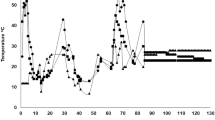Abstract
Composting is a process largely used to solve the organic material disposal problem, but composting of the olive husks produced by two-phase technology remains largely unknown. Because of their high content of salts, polyphenols, fatty acids and tannins, husk utilisation as fertiliser is not possible. Composting of the husks could permit the reduction of salt content and conversion of phenolic compounds into humic substances, but the knowledge about conditions of starting up, running the plant, degradation and microbiological characteristics of the cured compost has to be improved. Trials were carried out with uninoculated (A), and inoculated (B) piles and the process was monitored by ATP content and a pool of enzyme activities. The results showed that the performance of the process improved from pile A to pile B and ATP and mainly a pool of enzyme activities (alkaline phosphatase, esterase, esterase-lipase, phosphoamidase, β-galactosidase, β-gluco-sidase) showed effectiveness in the description of process. Finally, the molecular methods used to detect faecal contaminants in the cured compost resulted to be reliable.
Access this chapter
Tax calculation will be finalised at checkout
Purchases are for personal use only
Preview
Unable to display preview. Download preview PDF.
Similar content being viewed by others
References
Anonymous (1998) Directive 98/488 on eco-label soil improver. 7 April 1998
Bethelet M, Whyte LG, Greer CW (1996) Rapid, direct extraction of DNA from soils for PCR analysis using polyvinylpolypyrrolidone spin columns. FEMS Microbiol Lett 138: 17–22
DI.VAPRA-IPLA (1992) Metodi di analisi dei compost. Collana Ambiente, Torino Pile Composting of Two-phase Centrifuged Olive Husks: Bioindicators of the Process 175
Epstein E (1997) The science of composting. Technomic Publishing, Lancaster, Pennsylvania
Hermann RF, Shann JF (1993) Enzyme activities as indicators of municipal solid waste compost maturity. Compost Sci Util 4: 54–63
Humble W, King A, Phillips I (1977) APIZYM: a simple rapid system for the detection of bacterial enzymes. J Clin Pathol 30: 275–277
Hussong D, Burge WD, Enkiri NK (1985) Occurrence, growth and suppression of Salmonellae in composted sewage sludge. Appl Environ Microbiol 50 (4): 887–893
Malik M, Kain J, Pettigrew C, Ogram A (1994) Purification and molecular analysis of microbial DNA from compost. J Microbiol Meth ods 20: 183–196
Pfaller SL, Vesper SJ, Moreno H (1994). The use of PCR to detect a pathogen in compost. Compost Sci Util 2: 48–54
Ranalli G, Bottura G, Taddei P, Garavani M, Marchetti R, Sorlini C (2001) Composting of solid and sludge residues from agricultural and food industries. Bioindicators of monitoring and compost maturity. J Environ Sci Health, 36 (4): 415–436
SAS Institute Inc (1989) SAS/STAT User’s Guide, Version 6, 4th edn. SAS Institute, Cary NC
Sciancalepore V, Colangelo M, Sorlini C, Ranalli G (1996) Composting of effluent from a new two-phase centrifuge olive mill. Microbial characterization of the compost. Toxicol Environ Chem 55: 145–158
Swamy SC, Barnhart HM, Lee MD, Dreesen DW (1996). Virulence determinants invA and spvC in salmonellae isolated from poultry products, wastewater, and human sources. Appl Environ Microbiol 62: 3768–3771
Tseng DY, Chalmers JJ, Tuovinen OH (1996) ATP measurement in compost. Compost Sci Util 4 (3): 6–17
Wang RF, Cao WW, Cerniglia CE (1997) A universal protocol for PCR detection of 13 species of foodborne pathogens in foods. J Appl Microbiol 83: 727–736
Author information
Authors and Affiliations
Editor information
Editors and Affiliations
Rights and permissions
Copyright information
© 2002 Springer-Verlag Berlin Heidelberg
About this paper
Cite this paper
Ranalli, G., Principi, P., Zucchi, M., da Borso, F., Catalano, L., Sorlini, C. (2002). Pile Composting of Two-phase Centrifuged Olive Husks: Bioindicators of the Process. In: Insam, H., Riddech, N., Klammer, S. (eds) Microbiology of Composting. Springer, Berlin, Heidelberg. https://doi.org/10.1007/978-3-662-08724-4_14
Download citation
DOI: https://doi.org/10.1007/978-3-662-08724-4_14
Publisher Name: Springer, Berlin, Heidelberg
Print ISBN: 978-3-642-08705-9
Online ISBN: 978-3-662-08724-4
eBook Packages: Springer Book Archive




